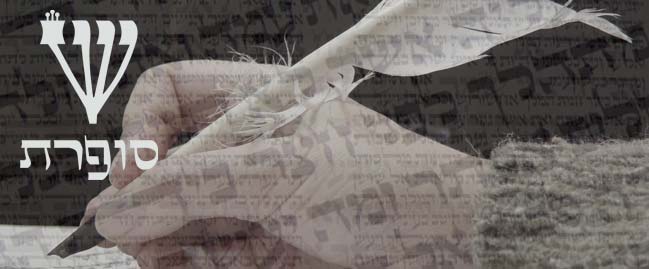DELIGHT
בס"ד
12 Sh'vat
I was very glad to get my copy of the JOFA Journal today in the mail & so happy to see that my former rabbi & constant friend, R' Ross Singer, had his article on women being permitted to write Megilot (Scrolls of) Esther published in the Winter 2006 issue. If you go here & click on the top link, Leadership, you can download your very own pdf! BTW, I always wanted to be that lady on page 5 when I grew up...
& yea, I am the female congregant mentioned in the piece.
So kol ha-kavod to the Jewish Orthodox Feminist Alliance, who has done much work in the service of Jewish women everywhere, helping us to not so much "think outside the box", as it were, but turn that box into more of a bag, as I like to say :)
The other TOTALLY cool thing is that they really did their own research on this & in the little box on the bottom left of page 4 names some of the women we know practiced sofrut - were copyists Jewish holy books & possibly wrote Sifrei Torah - & who appear throughout this blog. 3 cheers for an establishment of the existence of a historic soferet tradition!
(doing the wave...)
The original article (researched in 2002), much longer & full of Halakhic consideration, appears below:
In the preface to his book, Women Jewish Lay and Modernity, Rabbi Joel Wolowelsky charts a new course for exploring the inclusion of women in religious ritual and practice. He states, “given the overall friction between ideology and halakhah, Orthodox leaders have been suspicious of arguable constructive suggestions for increased women’s participation in religious activities on the grounds that accepting them could legitimize feminism in the eyes of the halakhic community. It is now time to move past this fear of feminism. We are fast approaching a post-feminist age in which accepting specific proposals originally promoted by feminists no longer carries the implication that we accept feminist ideology as a whole... It is time for a lekhatehilah encouragement of increased women’s involvement in a wide spectrum of religious activities.” (pg. x-xii) Rabbi Wolowelsky welcomes his readers to “suggest additional areas to explore,’ with the proviso that these “should be explored in classical term, with reference to classic texts and recognized authorities.” (pg. xii) In the spirit of this approach, the following essay will explore the issue of women writing Megillot Esther for ritual use on Purim.
I. Talmud regards Women as Pesulot for the writing of Tefilin.
The key text from which to begin this discussion is a beraita that appears in Mesekhet Gittin (45b). We read, “Rav Hamnuna son of Rava from Pashronia taught a Sefer Torah, Tefilin, and Mezuzot written by an informer, an idolater, a slave, a woman, a minor, a Samaritan or an apostate are invalid, as it says ‘you shall bind them (tefilin) you shall write them (mezuzot)’ -- those who fall under the Mitzvah of binding them are those who fall under the category of writing them.” This passage serves as the source for the unequivocal halakhah that women are pesulot to write tefilin. This position is unchallenged in the classical rabbinic literature.
II. The position of the Rishonim and Ahronim on women writing Sifrei Torah and Mezuzot.
While the pesul to write tefilin is not contested, there is a debate regarding the kashrut of women to write Sifrei Torah and mezuzot. A close examination of Rav Hamnuna’s beraita shows some ambiguity. The beraita does not make any distinction between tefilin and Sifrei Torah and Mezuzah. Yet, the reasoning of “those who are in the category of binding are in the category of writing” seems to apply only to Tefilin. Strikingly, in the Tur’s list of those who are pasul to write Tefilin, he includes women. Yet, when he lists those who are pesulot to write Sifre Torah , he omits women. One could infer from this that the Tur reads the beraitta’s exclusion of women as limited to Tefilin. Indeed, the Drisha suggests that not only the Tur, but the Rif and the Rosh all hold that this is the Halakah On the other hand, the Rambam does not omit women from his listing of those who are pasul to write Sifrei Torah and Mezuzot. The Shulhan Arukh explicitly states that women are invalid to write Sifre Torah.
This mahloket between the Shulchan Arukh and the Drishah has implications for the question of women writing Megilat Esther. According to the Derisha’s understanding, women’s exclusion is limited to Tefilin, therefore they would be considered valid for Sifre Torah and Mezuzot, and all the more so for Megilat Esther which is of a lesser status and in which they have an obligation to hear the ritual reading. For the Shulhan Arukh who states that women are pesulot to write Sifre Torah it is more complicated. It must be determined whether the strictures of writing a Sefer Torah apply to Megilat Esther. If they do, then according to the Shulhan Arukh women will be pesulot. If not, it will be possible to consider women kesherot to write the Megillah.
III. The Mahloket Rabeinu Tam and the Maggid Mishneh on the pesulim for Megilat Esther
The question as to whether the pasul stated in Rav Hamnuna’s beraita applies to Megilat Esther is not explicitly addressed in the Classical Rabbinic literature or in the Rishonim. However a related issue brought up by the Rishonim is exceedingly relevant to this matter. One of the requirements of a Sefer Torah is that its parchment must be dressed or worked lishmah. The Rishonim differ as to whether this requirement extends also to Megilat Esther. Rabbeinu Tam holds that the skin of the parchment must be dressed lishmah. He reasons that since the Megilah is called a Sefer, all the laws of a Sefer Torah apply to it except those that the tradition explicitly informs us are different. Given that the Classical Rabbinic literature never explicitly states that women may write a valid Megilat Esther, it is logical to presume that Rabbeinu Tam’s position would be that women are pesulot for writing the Megilah. However, the Rambam (Hilkhot Megilah 2:9) writes that one need not dress the leather of parchment lishmah. The Magid Mishneh commenting on this passage writes that “this is obvious for dressing was not mentioned with regard to it, and it (Megilah) is only like a sefer Torah with regard to those things in which(it megillah) was compared to it (Sefer Torah).” Here we find the Maggid Mishneh taking a position diametrically opposed to the view of Rabbeinu Tam. While Rabbeinu Tam suggests that Megillah is treated like a Sefer Torah unless Hazal instruct us otherwise, the Maggid Mishneh suggests that the Megillah is treated like a Sefer Torah only when Hazal explicitly tell us so. The Maggid Mishneh’s logic would lead one to conclude that women are valid to write Megilat Esther because Hazal never mentioned explicitly that they are Pasul. The Sdei Hemed cites the Radvaz as having the same understanding of the Rambam.
The Birkei Yosef uses this Maggid Mishneh to demonstrate that women are indeed valid to write the Megillah. He begins his line of reasoning by noting the Tosafot‘s discussion of the validity of women to prepare tzitzit and lulav. Tosafot conclude that the applicability of the derashah in Rav Hamnunah’s beraita is limited to Sefer Torah, Tefilin and Mezuzot only. This suggests that women may be kesharot to write other holy texts. Nevertheless, the Birkei Yosef suggests that this is an insufficient proof, since many regulations of the writing of the Megillah are identical to the requirements of writing of a Sefer Torah. He then notes the Maggid Mishneh’s position as one that would indeed allow women to write the Megillah. He observes that the Shulchan Arukh quotes both Rabbeinu Tam’s position on ibbud lishmah and the Rambam’s. The Rambam’s is brought first, stam while Rabbeinu Tam’s is brought as a yesh omrim. This the Birkei Yosef states is indicative that the Shulhan Arukh is deciding in favour of the Rambam. Therefore based on the Maggid Mishneh’s understanding of the Rambam, the Birkei Yosef concludes that the Shulchan Arukh is Paskening that women are kesherot to write Megilat Esther. He bolsters this by noting that the Pri Chadash validates bedeiavad a Megillah written with the left hand even though a Sefer Torah written that way is invalid.
In his shiurei Berakhah, the Hida brings another proof to bolster his claim that women are valid to write the Megillah. The gemara states that it is forbidden to read the megillah from a scroll that contains other sacred writings in public. From this it is deduced that in private one may read the Megillah from such a scroll. Since women are valid to write sacred writings other than Sifrei Torah as deduced in Tosafot, one must conclude that women are valid to write megilat Eshter. If not the gemara could not have allowed one to read privately from such a scroll, for it may have been written by a woman.
IV. Women’s obligation to read/hear the Megillah validates them to write it.
The Pri Megadim also holds that Rav Hamnunah’s beraita cannot be used as a source to invalidate women from writing the Megilah. This beraita excludes women from writing because they are not obligated in the Mitzvah of Tefilin. The Pri Megadim reasons that since women are obligated (minimally to hear ) in the Mitzvah of keriat Hamegillah they are valid to write it. This approach is echoed by the Sdei Hemed who quotes from Masekhet Sofrim. Masekhet Sofrim states the following rule: all who are eligible to fulfill the community’s obligation to read a sacred text are valid to write that text. Given that women are obligated in the Mitzvah of Megillah, one can draw the conclusion that women are valid to write the Megilah. However it is not so simple. The Ba’al Halakhot Gedolot (Behag) holds that women are obligated only to hear the Megillah read to them, but are invalid to read the Megillah for men. According to the Behag, the rule enunciated in Masekhet Sofrim would not validate women to write Megilat Esther. Indeed, the Ma’aseh Rokeach invalidates women using this very reasoning. Nevertheless, the Sdei Hemed finds reason to validate women to write the Megillah from another source. The Mishnah in Gittin (22b) states that women are valid to write gittin. The Sdei Hemed (eliyahu tzvi) reasons that their validity flows from the fact that the laws of gittin are applicable to women. Based on this reasoning, it is sufficient for women merely to be obligated in hearing the Megillah to render them valid to write it.
The Avnei Nezer raises a serious objection to this approach articulated by the Pri Megadim. According to the Pri Megadim women are valid to write sacred texts for which they have halakhic obligations. Yet, while women are obligated in the mitzvah of Mezuzah the beraita invalidates them from writing mezzuzot. The Arukh Hashulhan answers this difficulty. He explains that the pasul extends to Mezzuzot since they appear in the same paragraph with Tefilin, whereas Megillah is obviously not mentioned in that paragraph of the Torah.
V. The Megillah itself suggests that women are valid to write it.
Megillat Esther (Ch.9:29) states, “Then Esther the queen, the daughter of Avihail, and Mordekhay the Jew, wrote with all emphasis, to confirm this second letter of Purim.” The Targum renders this verse as saying “Esther the daughter of Avihail and Mordekhai the Jew wrote all this Megillah.” Rabbi David Oppenheim deduces from the Targum’s suggestion that Esther herself wrote the Megillah that women must be valid for writing the Megilah. A woman wrote the very first one! R. Oppenheim notes that this verse is used in the gemara (Megilah 19a) to derive halakhot. There the gemara asks “from where do we know that the Megilah requires parchment and ink? For it says (in one context) ‘and Esther the queen wrote,’ (and in another context) it is written ‘and I write on the scroll (parchment) and with ink.’” Using the rabbinic hermeneutical device of gezerah shavah the gemara deduces that the scroll of Esther must be on parchment and ink. R. Oppenheim reasons that if the gemara learns the halakhic details of parchment and ink from this verse, certainly we can learn that women are valid from the fact that it says Esther wrote.”
While R. Oppenheim uses Esther 9:29 as a proof that women are kesherot to write the Megillah, R. Meir Pearles reads that verse as a support for his position that women are pesulot. In his Megilat Sefer, R. Pearles argues that the Megillah has all the strictures of a Sefer Torah. In taking this position, he alludes to a Talmudic passage from Masekhet Megilah (16b). There Rabbi Tanhum and some say Rabbi Asi states that passage “words of peace and truth” in the Megillah teach us that the Megillah requires marking lines (shirtut) like “the truth of Torah.” R. Pearles argues that just as the Megillah requires shirtut so to all laws of Sifrei Torah apply to Megillat Esther. To strengthen his position he takes note that Esther 9:29 explicitly mentions that Mordecai also wrote the Megilah. R. Pearles suggests that had Mordekhai not assisted Esther, then the Megillah that they wrote would not have been valid. Based upon this reading he suggests that women are valid if the write with the assistance of a man. He finds support for this approach in the halakhot pertaining to sewing the parchments of the Megillat together. While the Sefer Torah needs to be sewn together only with animal tendons, the Megilah is kosher if it has three sections sewn together with tendons and the rest sewn together with linen. R. Pearles understands this halakhah to teach us that the writing of the Megilah is to be done basically as the writing of a Sefer Torah is done. However for the writing of the Megillah, the regulations need not be adhered to as strictly as for the Torah. The Megillah needs to be sewn with tendons, but not in its entirety, so too the Megillah needs to be written by a man, but not in its entirety. Esther’s contribution mentioned in Esther 9:29 does not invalidate the Megillah.
Rabbi Eliezer Waldenberg finds R. Pearles’ arguments unconvincing. He notes that the Megilat Sefer starts by suggesting that Megilat Esther has the same halakhot as a Sefer Torah. He then backtracks and suggests that megilat Esther does not quite have the same halakhic requirements as a Sefer Torah and may be written by a woman as long as she has help from a man. R. Waldenberg argues that wither the Megillah has the same requirements as a Sefer Torah or it does not. If it does not, then we must allow for the possibility that women are valid. R. Waldenberg finds R. Pearles’ reading of Esther 9:29 excessively casuistic.
V. An explicit mention of women being pesulot is absent in the codes.
Above we mentioned the Avnei Nezer’s objection to the Pri Megadim’s claim that women are valid to write Megillat Esther. Later the Avnei Nezer had second thoughts about his position. This change of mind was based on the fact that the Rambam omitted any mention of women being pesulot in his list of those who are pasul to write the Megilah. This Shulhan Arukh similarly omits women from his list of those who are pasul to write the megillah. Based on this other Ahronim also conclude that there is not pesul for women to write the megillah.
VI. Conclusion
A number of Ahronim write that women are invalid to write the Megillah. These include: the Maaseh Rokeah, R. Meir Pearles, R. Akiva Eiger, R Yosef Messas, Lishkat Hasofer , and the Shaarey Teshuvah. Nevertheless there is a strong trend in Halakhah to validate women to write Megillot. The Drishah would validate women to write all sacred texts save Tefilin. While the Shulhan Arukh disagrees with the Drishah, he omits women from his list of those who are pesulim to write the Megillah. A large number of major ahronim indeed rule either l’halakhah or l’ma’aseh that women are keshairot. These Ahronim include R. David Oppenheim, the Chida, the Pri Megadim, the Teshuvah Me’ahavah, the Sdei Hemed, the Arukh Hashulhan, the Avnei Nezer, the Beit Oved, and the Tzitz Eliezer. Given the number, stature, and compelling reasoning of these Ahronim, it seems that the weight of the halakhic discussion inclines toward permitting women to write megillot Esther for communal ritual use provided that they are competent in the requisite Halakhot.
This appeared in issue 42 of the Edah Journal in 2004 as well, followed by no less than 52 sources in his list of notes. He is truly the world authority on this subject. It's so great that his work is getting more attention & that both Jewish women & men are being duly educated about ways in which we can safely expand our practice while keeping our traditions intact.
Way to go, R' Ross!
Technorati tags: religion, Judaism, Torah, women, politics, Orthodoxy, Megillah, tefilin, soferet, scribe.














3 Comments:
Very interesting indeed, Aviel! Took me awhile to get through, but it was worth it.
R' Ross is the man!
בס"ד
Ain't he, tho'! & so thorough!
We were SO lucky to have him at Shaarey Tefilah. BTW, he's coming mid-March to be the scholar-in-residence for a Shabbaton we're holding in his honour...he's interviewing for a postion at King David High School here & we're *all* hoping he'll get the job. Like, hoping in a way that makes one unconsciously bounce from foot to foot...
Post a Comment
<< Home